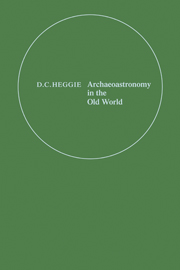Book contents
- Frontmatter
- Contents
- PREFACE
- LIST OF CONTRIBUTORS
- INVITED PAPERS
- CONTRIBUTED PAPERS
- A SURVEY OF THE BARBROOK STONE CIRCLES AND THEIR CLAIMED ASTRONOMICAL ALIGNMENTS
- OBSERVATIONS AT KINTRAW
- DECODING THE CALLANISH COMPLEX - A PROGRESS REPORT
- ASTRONOMY AND STONE ALIGNMENTS IN S.W. IRELAND
- STONE RINGS OF NORTHERN POLAND
- ASTRONOMICAL ORIENTATION OF NEOLITHIC SITES IN CENTRAL EUROPE
- STONE CIRCLE GEOMETRIES: AN INFORMATION THEORY APPROACH
- INVITED PAPER
- INDEX
STONE CIRCLE GEOMETRIES: AN INFORMATION THEORY APPROACH
Published online by Cambridge University Press: 05 November 2011
- Frontmatter
- Contents
- PREFACE
- LIST OF CONTRIBUTORS
- INVITED PAPERS
- CONTRIBUTED PAPERS
- A SURVEY OF THE BARBROOK STONE CIRCLES AND THEIR CLAIMED ASTRONOMICAL ALIGNMENTS
- OBSERVATIONS AT KINTRAW
- DECODING THE CALLANISH COMPLEX - A PROGRESS REPORT
- ASTRONOMY AND STONE ALIGNMENTS IN S.W. IRELAND
- STONE RINGS OF NORTHERN POLAND
- ASTRONOMICAL ORIENTATION OF NEOLITHIC SITES IN CENTRAL EUROPE
- STONE CIRCLE GEOMETRIES: AN INFORMATION THEORY APPROACH
- INVITED PAPER
- INDEX
Summary
Abstract. This article discusses the techniques of A. Thom in deriving geometric designs to fit stone circles and from this background argues for an alternative definition of an hypothesis in scientific research. The definition that is advocated herein is a union of Solomonoff's application of Information Theory to inductive inference, Wallace's Information measures and Halstead's software science measures. This approach is applied to the comparison of Thom's hypothesis against the authors' hypothesis that stone circles are meant to be roughly circular and locally smooth to the eye. The authors' hypothesis is modelled by a fourier series wrapped around a circle. The results from 65 Irish sites show that the authors' hypothesis is favoured at odds of better than 780:1 compared to Thom's hypothesis.
INTRODUCTION
The stone circles of Britain have undergone detailed study and statistical analysis over the past decade. The progenitor of this work, Professor A. Thom, claims that these monuments are set out to accurate geometric designs with the use of a standard unit of length, the ‘megalithic yard’ (MY) equal to .829m or 2.72 ft (Thom 1967). This claim has been investigated in two recent statistical analyses which both concluded that only the stone circles from Scotland lent some support to Thom's theories (Kendall 1974; Freeman 1976). Both these studies as well as Thom's used about 200 circles whose diameters were estimated by Thom.
- Type
- Chapter
- Information
- Archaeoastronomy in the Old World , pp. 231 - 264Publisher: Cambridge University PressPrint publication year: 1982
- 4
- Cited by



